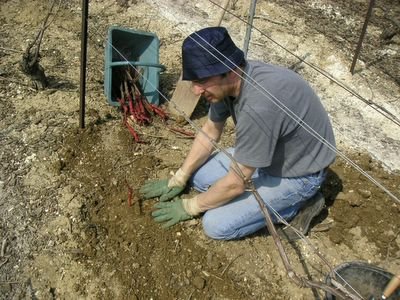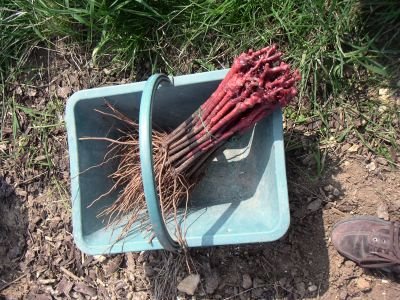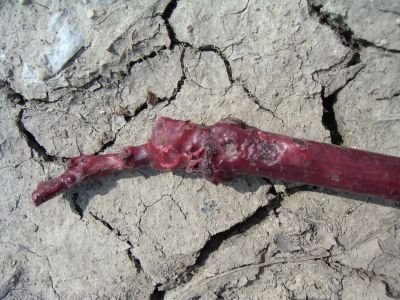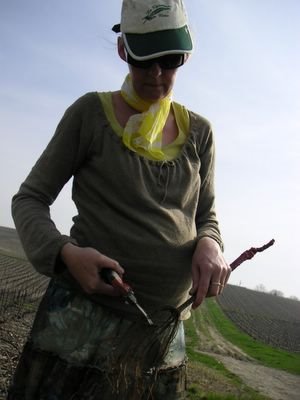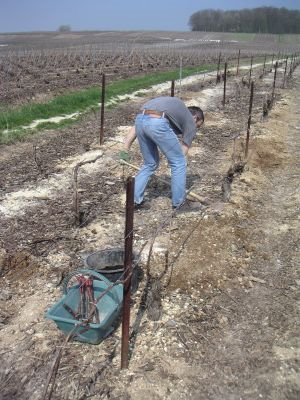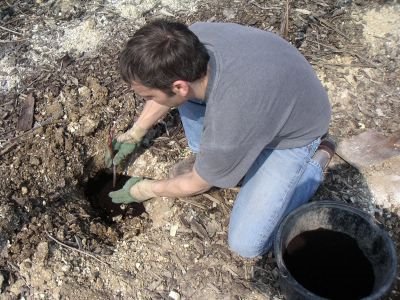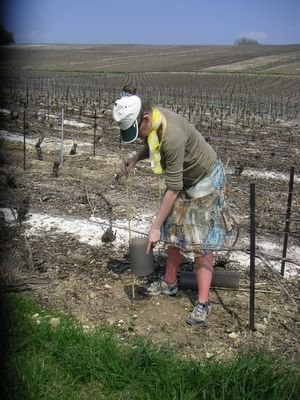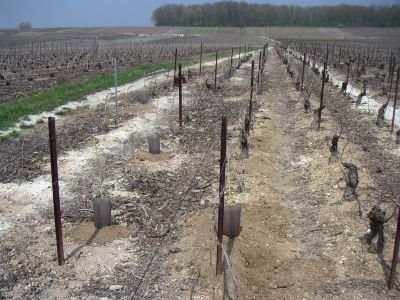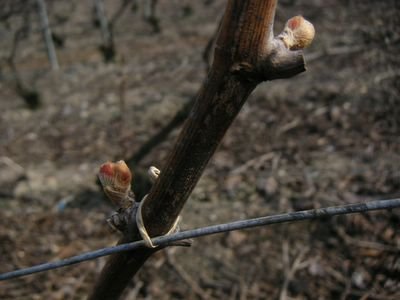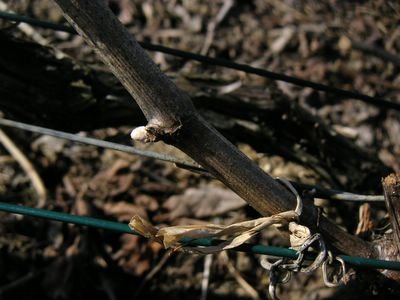I have made it through the exam in pruning. And please note: This is no April fool.
The test - in the beginning our teacher a bit patronizing described it as "not excactly A-levels" - is amongst the most challenging ones, I have done so far, so I am very pleased indeed.
Today Alain is up. I worry less for him; I think he - as a winegrower and a winegrower's son - should be able to bring home the
secateur d’or - the golden scissors - but he says, he does not care.
Next Saint Vincent we will hold each others and our childrens hands and join the procession through Verzy with final stop in one of the champagnehouses of the village. At the
vin d'honneur we will then get our diplomas. What a day! My name - with the others from Verzy who has passed the test - will be mentioned in the paper l'Union, which is certainly something I compare with the proud moment of the first article on print all way back to the days of Journalism school. I am quite convinced that I am the first Dane in Champagne to do and pass this test as well.
60 percent made itNow readers, who have been patient with me and read about my efforts with the pruning during these last months, may wonder about my judgement of my own abilitites, since I right before the exam gave myself a merely five percent chance to pass. Well, I still think so. But I happened to be so lucky that the one parameter completely out of my control, happened to come out to my advantage. Simply, I was marked by a friendly jury.
Not everybody was that lucky. Or qualified. Out of about 200 candidates, who arrived in the morning, 61% could leave the
vendangeoir of Veuve Clicquot in Bisseuil with the knowledge that they made it all the way to the certificate.
This is only one step or maybe two above that of unskilled labour, but it is a piece of paper, that can get you a job in this region. And a job, that is better payed than work in a factory as well. As late as in this week the demand and the continued expected demand of labourers in the vineyards were mentioned in one of the magazines of the business.
Now, I am not excactly on my way out into the rows of the neighbours with my secateur. But I could and anyway I expect to work in our vineyards next winter. So far we have had 180 hours of pruning and 80 hours of attaching, but with the extra half a hectare we expect to get next autumn, the amount of work will almost double.
They sent a ladyFriday morning in Bisseuil. A couple of hundred people are queing up outside the dining hall at one of the harvesthouses of the Veuve Clicquot. When it comes to style, this is rather far away from the ordinary yellowish-orange elegance of the great brand. This is rather basic: Concrete and wooden tables with benches and no hullabaloo whatsoever. Not even a single commercial poster to decorate the two walls without windows.
Anyway, everybody seems to concentrate on their tables: You have to find the one with a number that corresponds with the piece of paper given to you during the course. A piece of paper that also works as admittance today. So I steer for number 20.
And this is where we all wait, until everybody has shown their id's at the secretary's desk at the very entrance of the room. Only then the members of the juries enter the room and head for their tables. Until now they have been waiting next door packed like sardines in a tin. Once again we show our papers, to make sure everybody has placed themselves at the right table.
I am annoyed as I see an elderly lady amongst our examiners. Until now I have planned to use my extra eight kilos due to pregnancy to excuse my slowness when working - not completely unfair - and also the fact that I cannot really control the number of buds on the lower parts of the plant. No holds are barred.
But this lady probably has children of her own, and maybe she never tried these problems herself, I worry. Maybe she will dismiss my puffs and blows as just nonsense. Later this morning I however shall become more than satisfied with both the lady and her collegues. But this is half past seven in the morning and everybody so far seem rather harsh.
Call-over of the failed onesThe written test is distributed. As known from the last many thursdays, it consists of 10 questions to answer during seven minutes. It is piece of cake.
- Where is autres cru placed on the échelle de crus?
- Which pruning methods can you use in Grand Cru-areas?
- How many buds can you leave on a prolongement of a Cordon de Royat-pruned Pinot Noir?
And so on, when you have mugged up nothing but this for two months, the major risk of mistakes is more that you scan rather than read the questions, and therefor do not catch possible tricky nuances, before you answer.
However, I am quite convinced that I have made 10 good anwers out of 10, and when the chairman of the organization, that is in charge of the exam, announces, that the seven minutes are over, I have been finished the last couple of minutes. Many others too, I reckon, I just have not had that much of a surplus to check their performance as well.
All 200 are sent outside, and all those whose numbers are not read out, are to continue to the practical test in the village of Avenay val d’Or a couple of kilometres from here. I concentrate about the numbers only – getting numbers right is one of the most difficult disciplines in French – so I do not have any surplus to find out where to go now whatsoever.
The chairman has given, so it seems to me, rather complicated driving instructions just after the written test was finished, but I understood next to nothing of all that. I check with my female examiner, that I will start with
Chablis. At least I have gotten this much right.
But where they are, these
Chablis, I have no clue, and since I - wrongly - suppose that it cannot be the same place as the
Cordon de Royat, I panic. Which direction is now supposed to be mine? The only thing I know is that the five others from my table are going to the same place, but I have already forgotten what they looked like, and my jury will be lost as I go to the car to pick up my tools.
Alain arrives and gets hold of our teacher, Stéphanie, who today is here as an examiner. She explains, where we are going now. Apparently everything grows in the same spot, and there is plenty of time to get there. Soon the real trial of the day is about to begin.
"Vite, vite, vite"As usual I attract attention as I arrive with my bucket: "C’est bientôt la vendange?" is a sentence, I have heard quite a few times now. Most
vignerons seem to use the same type of black plasticbucket for the grapeharvest. But together with little walks and stretching exercises I use it as a chair in order to keep my body as content as possible during the hour of waiting laying ahead of me.
We have arrived last of all, so I am at the back of the line. Which suits me fine, it gives me time to relax again, and also the possibility of noting that either our examiners are really nice or the other members of my group are very able, because not one of them fail, even we have had the
Chablis-pruning first, and it often contains more pitfalls than the
Cordon de Royat. It is so fast and easy unnecessarily to abolish a
charpente, that ought to have lived one more year, or on the other hand to keep one, that you ought to have removed.
But as the first four guys have made their way through, I can spot the test of the other female of our group just 20 metres in front of me. She kneels at the two vines, she is supposed to prune - not out of respect, the height of the vines is just very low - and we can see - Alain next to me - that it most certainly looks like one member of the jury is helping her. Also he looks very much like somebody we know from the village of Alain.
A few moments later I am signalled to approach and presented for the first vine that I must prune. I have already checked out what I could and seen that these vines seem to be much more regular and according to theory than what we have been used to in the course. On these vines you find the right kind of shoots from the bottom of the plant, the old
charpentes are not several metres long, and they all seem to have nice
rachets from last year with good possibilities of rejuvenation.
I cannot help getting nervous though as I have to remove a small and rather sad looking
charpente in order to avoid
superposition with my
lancement. The other three
charpentes are easy. My choices of
prolongements are not great though.
"Tu coupe là. Là, là, là," goes the examiner, who monitors my efforts at close quarters, and who is indeed the man, we already know. My eye is not great when it comes to the number of buds, this I already know.
Only the next day I remember that it is "
éliminatoire" if you leave a vine with more than four
charpentes. This I have completely forgotten, and it would have happened to me, if I had not removed the sad, young
charpente. It is so easy to forget a detail you would never fail when you work nice and easily in your own vineyards withput the pressure of an exam.
I can hear the examiners discuss, but not whether it concerns me or the woman who was in front of me:
"Elle sait tailler" – "she knows how to prune" – but also that this is too slow.
"Vite, vite, vite", says Christian, and I try my best to work faster, faster, faster.
Loose bindingsI have made it as far as to the attachments. At least the binding is not a performance on time. Christian slips a roll of thread into my hand rather than a piece that is already cut off. This removes another worry of mine: Will they be annoyed with me when I use more thread than average? On top of that, my bindings happen to be not excactly the tighest of their kind in Champagne.
The first one I miss completely, and I must start all over again. I can hear the examiners note that I do not seem to have gained a lot of experience in the art of attaching the vines. I explain that I have not really been able to practise much since my big and pregnant stomach is not very pleased when I have been in the fields to bind. In fact I have had to rest a full day after practising just an hour or two, which has made me sort of cautious when practising this discipline.
I hesitate as I reach my
lancement. Now, how will I avoid a
superposition, when you are only supposed to bend it forward or keep it vertical? One of the examiners tells me to bind it vertically, and I will be fine. So I follow orders.
You cannot fail the exam on your binding, and I do not think I have committed real serious trouble during my pruning. But I understand that my examiners have been more than gentle when it comes to time. You are not supposed to use more than eight minutes pruning your two plants, and even I have no clue whatsoever of the time, I have used, I am rather sure that I have been slow. But they let me move on to the next test - the
Cordon de Royat - which is already more than I would ever have expected.
Dispute about rejuvenation of the CordonOn a muddy piece of land with the
Chablis-grapes on one side and the
Cordon de Royat on the other, we meet up with Sébastien, Didier and Maxime, all known from the course of now many thursdays, and who try their luck this morning as well as me. We have all been lucky - some of us maybe even skilled - and made it through the first half of the test.
All of us extremely reliefed. That is, just as reliefed as you dare when you still have another half of the test in front of you. I will move on to the
Cordon de Royat, which at least Alain and I consider more easy than the
Chablis. It normally has less risks of fatal errors. But today, the
Cordon de Royat turns out to imply the most tricky of all traps imaginable.
To judge from opinions given from the candidates some of them fail because they follow rules, that at least we in our group have been taught to follow. The tricky part is the rejuvenation of the
Cordon de Royat. Excactly when are you supposed to do it?
We have been told to do a new
Cordon, when the old one covers a length of two thirds of the entire length between two plants. But apparently not all share this opinion, and today it is the examiners who decide. Several of them seem to rejuvenate at a much later stage than what has been taught at least in our class, where several fail the test apparently because of this.
I have gotten used to ask any owner of any vine, how he or she wants the vine pruned, since it seems nobody do it excactly the same. And apparently the AOC-rules - even they seem so detailed - can be interpretated in many ways by different persons. Also of course only an owner can know his or her excact local conditions which have to be taken into account as well.
I note that I am amongst the lucky ones with a jury that has not come here today to exercise their annual possibility of playing the powergame, but rather to evaluate whether I and the others in my group can actually prune or not.
Which I happen to think I am able to now. Even I feel blessed beyond imagination that I make it through both pruning tests, I also feel worthy of my paper, once it will arrive.
The oral trialMaybe I should mention that the last trial of the day - the oral examination - pass off in a very laid back way. A few days before friday a friend strongly urged me
not to neglect this last, dreadful part, after all "you never know". Some times you actually do make it - against almost all odds - and this is excactly the case today.
And I have followed his advice and actually
did prepare the oral part, and as I read my two questions, they just seem so easy, I can hardly believe it. I manage to write my answers down in a fashion so thoroughly that the censors do not really have any follow-up questions. Dismissed. I am free to leave, and I passed! The rest is to wait for my final points on the lawn outside.
Most of those who have made it all the way to the oral part, manage the last part too. But since half past seven this morning more than one third of the original number of candidates have been rejected for all sorts of reasons, amongst them Didier. This makes me sort of sad, since he actually needed this paper to get a job. I really sincerely hope that some
vigneron will give him a job anyway.
Our teacher Stéphanie gains a lot of points with me as she spend this hour in waiting with four mentally handicapped youngsters, that she has lead all this way, and who will now be able to find work, probably one of very few chances for them. One of them gains the famous
secateur d'or and with it probably even more warm wishes than anybody else here on the green lawn under the bright and warm April sunshine.
It is so nice to see, and it does undeniably put everything else during these last many weeks in perspective. So let me in that same spirit add, that our word blind bloke in his fifties also made it all the way through. That pleased me a lot to see. It has not been very pleasant for him - thursday after thursday - to get his handicap displayed in front of everybody, so it is nice at least to see him achieve what he came for in return.
The chairman has used the hour, we have to spend waiting, to improvise a little speach, where he in a very detailed manner - unfortunately my limited French makes me miss most of his examples, I still get the point though - sums up all the horrible mistakes he has found, seen and heard of this morning. Finally the points are published - name by name - with my 440 points there is an awful long way down to the 380 that are minimum to pass the limit. I wonder how I managed to collect all these nice little points all for myself. I mean, where on earth did they come from?
På danskCopyright: The copyright for text and photos at bobler.blogspot.com belongs to Solveig Tange. You may use my articles, photos or parts of them for non-commercial use and if I am credited as the author. Feel free to link to this site but not in your own frameset please.
Alain passes his test with no major difficulties the next day. No golden scissors but he can bring back some oil for the care of our
secateurs and a whetstone as a recognition of his skills in the art of pruning. We celebrate the good resultats with two guys from the course sharing a nice lunch and two bottles of champagne: The Blancs de Blanc and the rosé of Besserat de Bellefon, both very nice and gentle but maybe also a bit too tame, at least when you know how other brands with a stronger personality almost literally attack your taste buds. It is all a matter of preferance really.



